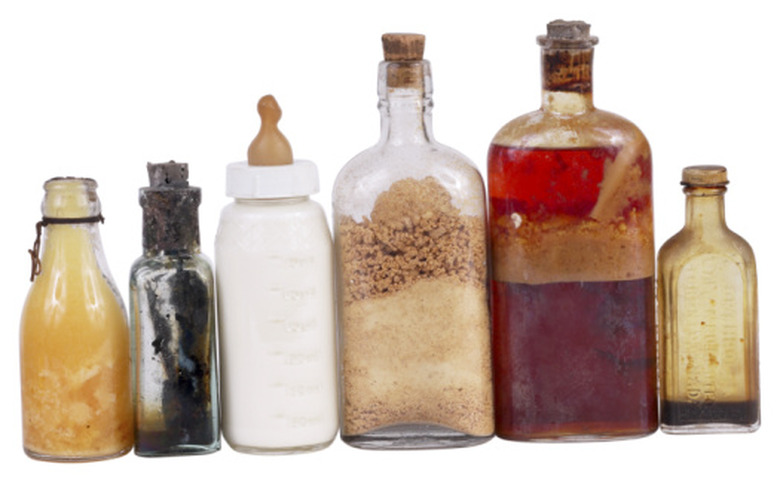Milk & Vinegar Experiment For A Science Fair
Identifying a topic for a science fair project can be as easy as checking the kitchen pantry or refrigerator. Often projects use household items. A base, such as milk, and an acid, such as vinegar, are two of the most common ingredients in science fair experiments.
Make Plastic Milk
Make Plastic Milk
A Science Bob experiment demonstrates how to make a malleable "blob" from milk and vinegar. Students will make casein, which is what forms when the protein in milk meets the acid in vinegar. Heat milk but don't let it come to a boil, then add a small amount of vinegar and stir. Pour the mixture through a strainer. Because the two liquids don't mix, blobs are formed. Rinse off the blobs when they cool and squeeze them together to form a ball or any shape you choose. Let it harden.
Students can do further tests, using different types of milk and varying acids. The resulting "plastic milk" and details on its creation can be displayed at a science fair.
Obtaining Water from Milk or Vinegar
Obtaining Water from Milk or Vinegar
Many natural liquids are a mixture of two or more chemicals, so a good project would be to attempt to separate or extract substances by changing a liquid's physical properties. For example, a Science Project experiment seeks to determine whether water can be extracted from ink, vinegar and/or milk by raising or lowering their temperatures.
Have students heat the milk in a covered pot, then lift the lid to see if any condensation has formed. If so, water has been extracted. Next, have them heat the vinegar the same way. Create a poster board explaining why this happens for display at a science fair.
Separation of Milk Particles
Separation of Milk Particles
An experiment by the Princeton Materials Institute seeks to demonstrate that milk is made of particles suspended in water. The project uses vinegar to create a mixture that generates small white particles in the milk. The vinegar (or nearly any kind of acid) causes coagulation of the particles or white clumps that can then be filtered out of the milk.
Start by pouring skim milk into a cup and adding vinegar. Stir, then pour the mixture through a coffee filter. Particles should be left behind. At a science fair, students can display the particles along with explanations as to how they were created and why.
Making Glue
Making Glue
Practical Chemistry describes an experiment that allows students to make glue from milk and vinegar. Different types of milk and vinegar produce glues of varying strength.
Measure 5 parts milk and 1 part vinegar into a beaker and heat, stirring constantly until small lumps begin to form. Turn off the heat and continue stirring until no more lumps form. Let the lumps settle, skim the liquid from the top and filter the rest of the mixture. The lumps, or curds, is what is filtered out. Add a small amount of water to the curds and stir until smooth. This is the glue.
This experiment helps students learn about proteins and other chemical substances. As part of a science fair display, the glue can be tested using two sticks and a weight.
Cite This Article
MLA
Ganci, Kerri. "Milk & Vinegar Experiment For A Science Fair" sciencing.com, https://www.sciencing.com/milk-vinegar-experiment-science-fair-8672295/. 24 April 2017.
APA
Ganci, Kerri. (2017, April 24). Milk & Vinegar Experiment For A Science Fair. sciencing.com. Retrieved from https://www.sciencing.com/milk-vinegar-experiment-science-fair-8672295/
Chicago
Ganci, Kerri. Milk & Vinegar Experiment For A Science Fair last modified August 30, 2022. https://www.sciencing.com/milk-vinegar-experiment-science-fair-8672295/
